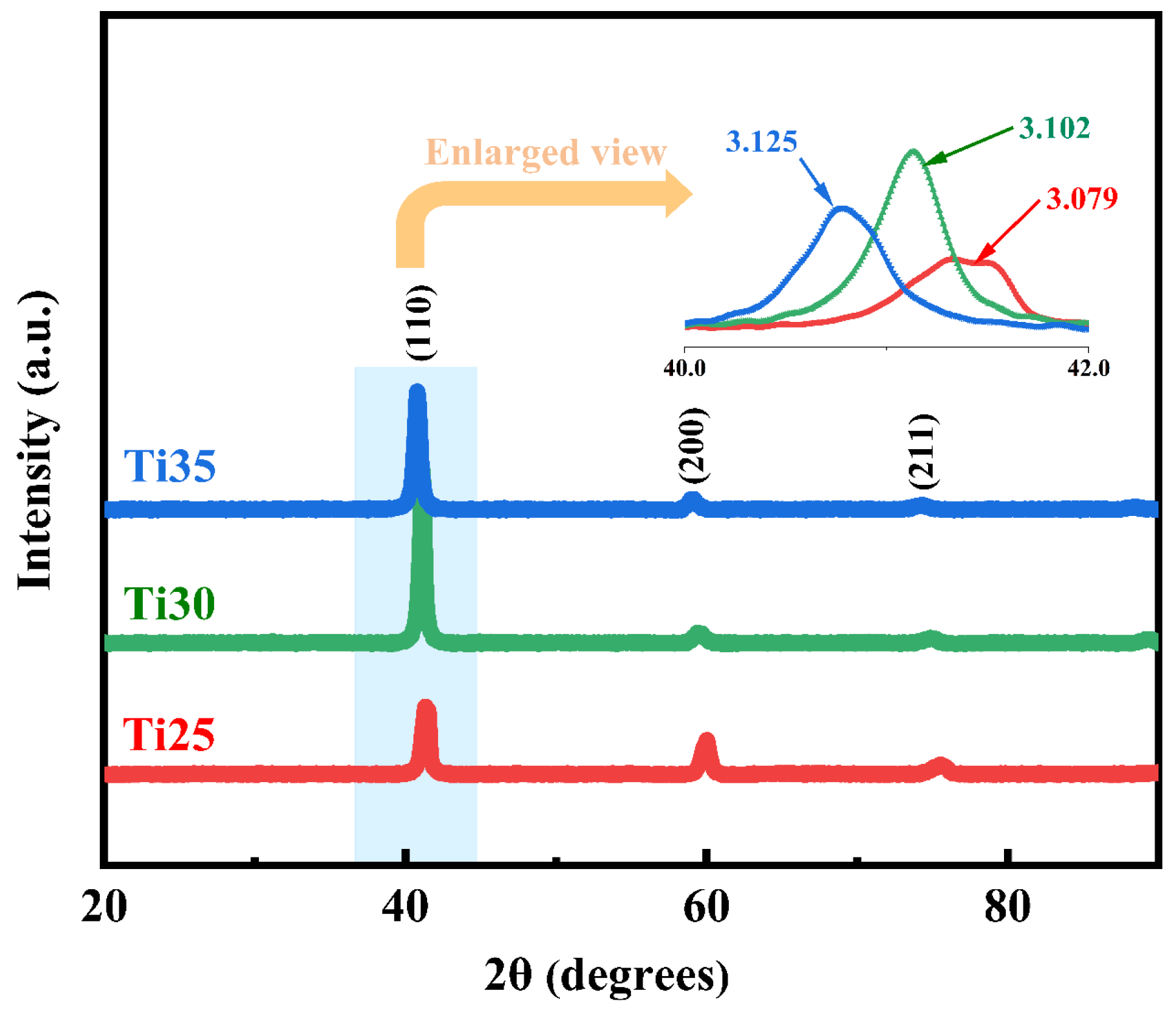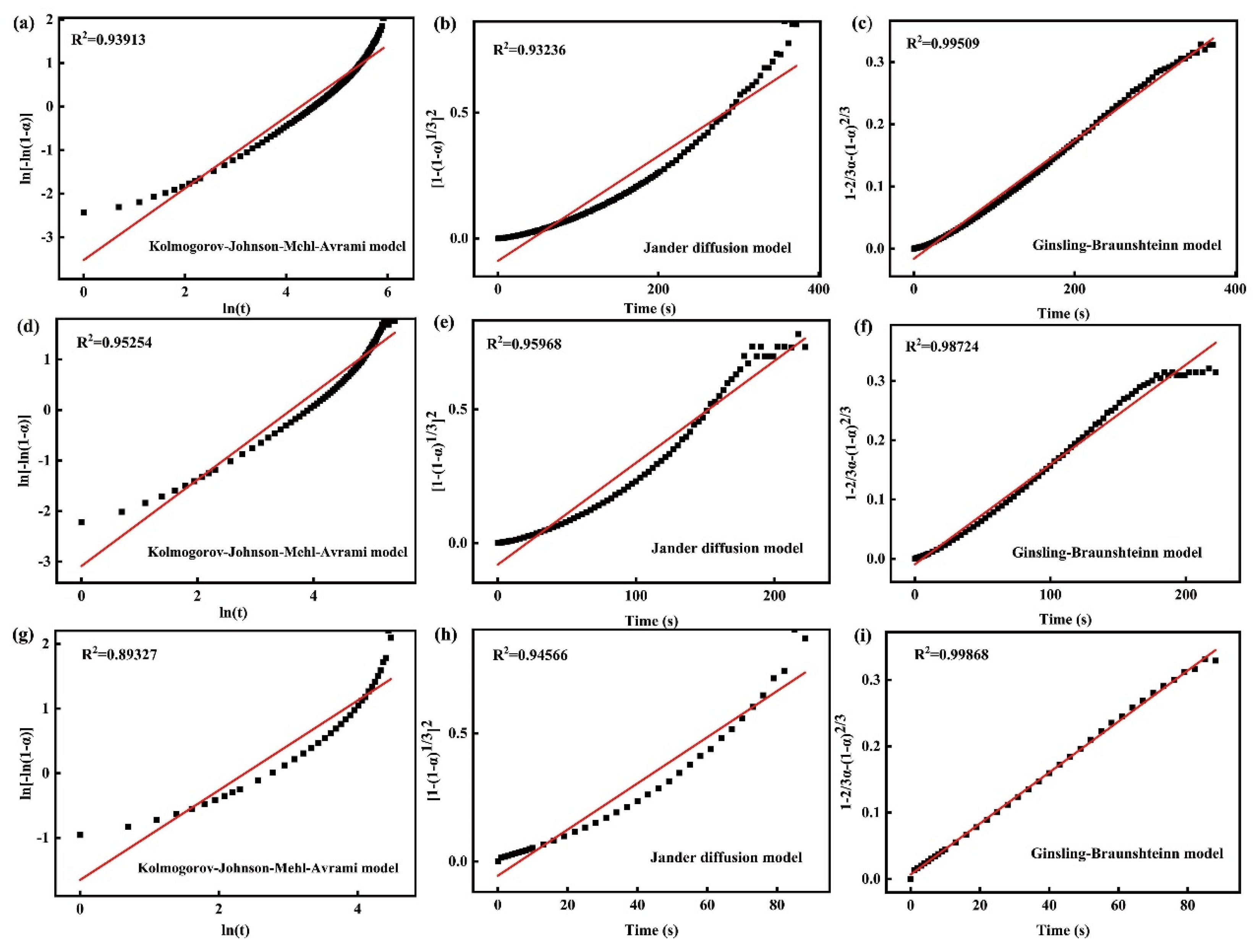Hydrogen Desorption Kinetics of V30Nb10(TixCr1–x)60 High-Entropy Alloys
Abstract
:1. Introduction
2. Materials and Methods
3. Results and Discussion
3.1. CALPHAD Calculations of TiVNbCr HEAs
3.2. XRD Phase and Microstructure
3.3. Hydrogen Absorption/Desorption Kinetics in TiVNbCr HEAs
3.4. Model Fitting of Hydrogen Desorption in TiVNbCr HEAs
4. Conclusions
- (1)
- According to CALPHAD calculations, the TiVNbCr series HEAs with different Cr contents were designed, and a BCC single-phase uniform structure was obtained by arc melting and heat treatment.
- (2)
- TiVNbCr HEAs with different Cr contents show fast hydrogen absorption kinetics, reaching maximum hydrogen absorption within 100 s at 300 K. Among those alloys, the maximum hydrogen storage capacity of V30Nb10Ti35Cr25 alloy reached 3.72 wt.% with a high hydrogen-to-metal ratio of 2. It takes ~700 s for the alloy to reach hydrogen release equilibrium, where 1.31 wt.%, 1.77 wt.%, and 2.06 wt.% capacity of hydrogen can be desorbed at 423 K, 443 K, and 473 K, respectively. Higher temperatures lead to faster hydrogen release kinetics as well as higher hydrogen desorption, and similar phenomena were found for V30Nb10Ti30Cr30 and V30Nb10Ti25Cr35 alloys.
- (3)
- The kinetic behavior of hydrogen desorption from TiVNbCr-based HEAs was successfully fitted. The fitted equations are consistent with the Ginsling–-Braunshteinn model of three-dimensional diffusion, and the main rate-controlling step of the hydrogen release kinetics is diffusion. Meanwhile, the diffusion activation energy of hydrogen release decreases with the increase in Cr content, and, thus, hydrogen release becomes easier.
Author Contributions
Funding
Data Availability Statement
Conflicts of Interest
References
- Amirthan, T.; Perera, M. The role of storage systems in hydrogen economy: A review. J. Nat. Gas Sci. Eng. 2022, 108, 104843. [Google Scholar] [CrossRef]
- Rusman, N.A.A.; Dahari, M. A review on the current progress of metal hydrides material for solid-state hydrogen storage applications. Int. J. Hydrogen Energy 2016, 41, 12108–12126. [Google Scholar] [CrossRef]
- Ouyang, L.; Liu, F.; Wang, H.; Liu, J.; Yang, X.S.; Sun, L.; Zhu, M. Magnesium-based hydrogen storage compounds: A review. J. Alloys Compd. 2020, 832, 154865. [Google Scholar] [CrossRef]
- Dematteis, E.M.; Berti, N.; Cuevas, F.; Latroche, M.; Baricco, M. Substitutional effects in TiFe for hydrogen storage: A comprehensive review. Mater. Adv. 2021, 2, 2524–2560. [Google Scholar] [CrossRef]
- Tousignant, M.; Huot, J. Hydrogen sorption enhancement in cold rolled LaNi5. J. Alloys Compd. 2014, 595, 22–27. [Google Scholar] [CrossRef]
- Marques, F.; Balcerzak, M.; Winkelmann, F.; Zepon, G.; Felderhoff, M. Review and outlook on high-entropy alloys for hydrogen storage. Energy Environ. Sci. 2021, 14, 5191–5227. [Google Scholar] [CrossRef]
- George, E.P.; Raabe, D.; Ritchie, R.O. High-entropy alloys. Nat. Rev. Mater. 2019, 4, 515–534. [Google Scholar] [CrossRef]
- Edalati, P.; Li, Y.; Zepon, G.; Li, H.; Edalati, K. Reversible room temperature hydrogen storage in high-entropy alloy TiZrCrMnFeNi. Scr. Mater. 2020, 178, 387–390. [Google Scholar] [CrossRef]
- Fang, F.; Li, Y.; Zhang, Q.; Sun, L.; Shao, Z.; Sun, D. Hydrogen storage properties of TiMn1.5V0.2-based alloys for application to fuel cell system. J. Power Sources 2010, 195, 8215–8221. [Google Scholar] [CrossRef]
- Qi, J.; Liang, Z.; Xiao, X.; Yao, Z.; Zhou, P.; Li, R.; Lv, L.; Zhang, X.; Kou, H.; Huang, X.; et al. Effect of isostructural phase transition on cycling stability of ZrCo-based alloys for hydrogen isotopes storage. Chem. Eng. J. 2022, 140571. [Google Scholar] [CrossRef]
- Yao, Z.; Xiao, X.; Liang, Z.; Huang, X.; Kou, H.; Luo, W.; Chen, C.; Chen, L. An in-depth study on the thermodynamics and kinetics of disproportionation behaviors in ZrCo-H system. J. Mater. Chem. A 2020, 8, 9322–9330. [Google Scholar] [CrossRef]
- Floriano, R.; Zepon, G.; Edalati, K.; Fontana, G.L.; Mohammadi, A.; Ma, Z.; Li, H.W.; Contieri, R.J. Hydrogen storage properties of new A3B2-type TiZrNbCrFe high-entropy alloy. Int. J. Hydrogen Energy 2021, 46, 23757–23766. [Google Scholar] [CrossRef]
- Sahlberg, M.; Karlsson, D.; Zlotea, C.; Jansson, U. Superior hydrogen storage in high entropy alloys. Sci. Rep. 2016, 6, 1–6. [Google Scholar] [CrossRef] [PubMed] [Green Version]
- Nygård, M.M.; Ek, G.; Karlsson, D.; Sahlberg, M.; Sørby, M.H.; Hauback, B.C. Hydrogen storage in high-entropy alloys with varying degree of local lattice strain. Int. J. Hydrogen Energy 2019, 44, 29140–29149. [Google Scholar] [CrossRef] [Green Version]
- Hu, J.; Zhang, J.; Li, M.; Zhang, S.; Xiao, H.; Xie, L.; Sun, G.; Shen, H.; Zhou, X.; Li, X.; et al. The origin of anomalous hydrogen occupation in high entropy alloys. J. Mater. Chem. A 2022, 10, 7228–7237. [Google Scholar] [CrossRef]
- Zhang, J.; Li, P.; Huang, G.; Zhang, W.; Hu, J.; Xiao, H.; Zheng, J.; Zhou, X.; Xiang, X.; Yu, J.; et al. Superior Hydrogen Sorption Kinetics of Ti0.20Zr0.20Hf0.20Nb0.40 High-Entropy Alloy. Metals 2021, 11, 470. [Google Scholar] [CrossRef]
- Ek, G.; Nygård, M.M.; Pavan, A.F.; Montero, J.; Henry, P.F.; Sørby, M.H.; Witman, M.; Stavila, V.; Zlotea, C.; Hauback, B.C.; et al. Elucidating the Effects of the Composition on Hydrogen Sorption in TiVZrNbHf-Based High-Entropy Alloys. Inorg. Chem. 2021, 60, 1124–1132. [Google Scholar] [CrossRef] [PubMed]
- Zhang, C.; Song, A.; Yuan, Y.; Wu, Y.; Zhang, P.; Lu, Z.; Song, X. Study on the hydrogen storage properties of a TiZrNbTa high entropy alloy. Int. J. Hydrogen Energy 2020, 45, 5367–5374. [Google Scholar] [CrossRef]
- Liu, J.; Xu, J.; Sleiman, S.; Ravalison, F.; Zhu, W.; Liu, H.; Cheng, H.; Huot, J. Hydrogen storage properties of V0.3Ti0.3Cr0.25Mn0.1Nb0.05 high entropy alloy. Int. J. Hydrogen Energy 2022, 47, 25724–25732. [Google Scholar] [CrossRef]
- Sleiman, S.; Huot, J. Effect of particle size, pressure and temperature on the activation process of hydrogen absorption in TiVZrHfNb high entropy alloy. J. Alloys Compd. 2021, 861, 158615. [Google Scholar] [CrossRef]
- Silva, B.H.; Zlotea, C.; Champion, Y.; Botta, W.J.; Zepon, G. Design of TiVNb-(Cr, Ni or Co) multicomponent alloys with the same valence electron concentration for hydrogen storage. J. Alloys Compd. 2021, 865, 158767. [Google Scholar] [CrossRef]
- Zhang, C.; Wu, Y.; You, L.; Cao, X.; Lu, Z.; Song, X. Investigation on the activation mechanism of hydrogen absorption in TiZrNbTa high entropy alloy. J. Alloys Compd. 2019, 781, 613–620. [Google Scholar] [CrossRef]
- Cheng, B.; Li, Y.; Li, X.; Ke, H.; Wang, L.; Cao, T.; Wan, D.; Wang, B.; Xue, Y. Solid-State Hydrogen Storage Properties of Ti–V–Nb–Cr High-Entropy Alloys and the Associated Efects of Transitional Metals (M=Mn, Fe, Ni). Acta Metall. Sin.-Engl. Lett. 2022, 1–10. [Google Scholar] [CrossRef]
- Wang, X.; Wang, L.; Li, T.; Jin, K.; Wang, B.; Li, Y.; Sun, S.; Xue, Y. Precipitation enhancing strain hardening capability of ductile AlTiVZrNb high-entropy alloys upon dynamic loading. Mater. Sci. Eng. A 2022, 856, 143964. [Google Scholar] [CrossRef]
- Wan, D.; Guan, S.; Wang, D.; Lu, X.; Ma, J. Hydrogen embrittlement of additively manufactured AlCoCrFeNi2.1 eutectic high-entropy alloy. Corros. Sci. 2022, 195, 110007. [Google Scholar] [CrossRef]
- Burke, J.; Turnbull, D. Recrystallization and grain growth. Prog. Met. Phys. 1952, 3, 220–292. [Google Scholar] [CrossRef]
- Wu, Y.; Zhao, W.; Jiang, L.; Li, Z.; Guo, X.; Ye, J.; Yuan, B.; Wang, S.; Hao, L. Effect of Fe and Al on hydrogen storage properties of 75 V-Ti-Cr alloys. J. Alloys Compd. 2021, 887, 161181. [Google Scholar] [CrossRef]
- Zhan, L.; Zhou, P.; Xiao, X.; Cao, Z.; Piao, M.; Li, Z.; Jiang, L.; Li, Z.; Chen, L. Numerical simulation and experimental validation of Ti0.95Zr0.05Mn0.9Cr0.9V0.2 alloy in a metal hydride tank for high-density hydrogen storage. Int. J. Hydrogen Energy 2022, 47, 38655–38670. [Google Scholar] [CrossRef]
- Shahi, R.; Gupta, A.; Kumari, P. Perspectives of high entropy alloys as hydrogen storage materials. Int. J. Hydrogen Energy 2022. [Google Scholar] [CrossRef]
- Nygård, M.M.; Ek, G.; Karlsson, D.; Sørby, M.H.; Sahlberg, M.; Hauback, B.C. Counting electrons—A new approach to tailor the hydrogen sorption properties of high-entropy alloys. Acta Mater. 2019, 175, 121–129. [Google Scholar] [CrossRef]
- Luo, Q.; Li, J.; Li, B.; Liu, B.; Shao, H.; Li, Q. Kinetics in Mg-based hydrogen storage materials: Enhancement and mechanism. J. Magnes. Alloy. 2019, 7, 58–71. [Google Scholar] [CrossRef]
- Zhang, S.; Ding, X.; Chen, R.; Zhang, J.; Su, Y.; Wu, S.; Guo, J. Modification of nano-eutectic structure and the relation on hydrogen storage properties: A novel Ti–V–Zr medium entropy alloy. Int. J. Hydrogen Energy 2022, 47, 34533–34544. [Google Scholar] [CrossRef]
- Martin, M.; Gommel, C.; Borkhart, C.; Fromm, E. Absorption and desorption kinetics of hydrogen storage alloys. J. Alloys Compd. 1996, 238, 193–201. [Google Scholar] [CrossRef]
- Fu, Y.; Ding, Z.; Ren, S.; Li, X.; Zhou, S.; Zhang, L.; Wang, W.; Wu, L.; Li, Y.; Han, S. Effect of in-situ formed Mg2Ni/Mg2NiH4 compounds on hydrogen storage performance of MgH2. Int. J. Hydrogen Energy 2020, 45, 28154–28162. [Google Scholar] [CrossRef]
- Sharp, J.H.; Brindley, G.W.; Achar, B.N. Numerical data for some commonly used solid state reaction equations. J. Am. Ceram. Soc. 1966, 49, 379–382. [Google Scholar] [CrossRef]
- Ginstling, A.M.; Brounshtein, B.I. Concerning the diffusion kinetics of reaction in spherical particle. J. Appl. Chem. USSR 1950, 23, 1327–1338. [Google Scholar]
- Ruz, P.; Banerjee, S.; Halder, R.; Kumar, A.; Sudarsan, V. Thermodynamics, kinetics and microstructural evolution of Ti0.43Zr0.07Cr0.25V0.25 alloy upon hydrogenation. Int. J. Hydrogen Energy 2017, 42, 11482–11492. [Google Scholar] [CrossRef]








| Alloys | Abbreviations | Ti Content (at.%) | V Content (at.%) | Nb Content (at.%) | Cr Content (at.%) |
|---|---|---|---|---|---|
| V30Nb10Ti25Cr35 | Ti25 | 25 | 30 | 10 | 35 |
| V30Nb10Ti30Cr30 | Ti30 | 30 | 30 | 10 | 30 |
| V30Nb10Ti35Cr25 | Ti35 | 35 | 30 | 10 | 25 |
| Alloys | Desorption | 353 K | 373 K | 393 K | 423 K | 443 K | 473 K |
|---|---|---|---|---|---|---|---|
| Ti25 | wt.% | 1.96 in 402 s | 2.21 in 202 s | / | 2.48 in 85 s | / | / |
| Ti30 | wt.% | / | / | 1.97 in 282 s | 2.10 in 230 s | 2.17 in 120 s | |
| Ti35 | wt.% | / | / | / | 1.31 in 740 s | 1.77 in 590 s | 2.06 in 400 s |
| Alloys | Temperature (K) | Rate Constant (k) | Activation Energy (kJ/mol) |
|---|---|---|---|
| Ti25 | 353 | 9.51 × 10−4 | 24.28 ± 2.29 |
| 373 | 1.68 × 10−3 | ||
| 423 | 3.84 × 10−3 | ||
| Ti30 | 393 | 1.09 × 10−3 | 25.96 ± 10.3 |
| 423 | 1.44 × 10−3 | ||
| 443 | 2.82 × 10−3 | ||
| Ti35 | 423 | 3.36 × 10−4 | 31.90 ± 4.83 |
| 443 | 5.78 × 10−4 | ||
| 473 | 8.89 × 10−4 |
Disclaimer/Publisher’s Note: The statements, opinions and data contained in all publications are solely those of the individual author(s) and contributor(s) and not of MDPI and/or the editor(s). MDPI and/or the editor(s) disclaim responsibility for any injury to people or property resulting from any ideas, methods, instructions or products referred to in the content. |
© 2023 by the authors. Licensee MDPI, Basel, Switzerland. This article is an open access article distributed under the terms and conditions of the Creative Commons Attribution (CC BY) license (https://creativecommons.org/licenses/by/4.0/).
Share and Cite
Cheng, B.; Kong, L.; Li, Y.; Wan, D.; Xue, Y. Hydrogen Desorption Kinetics of V30Nb10(TixCr1–x)60 High-Entropy Alloys. Metals 2023, 13, 230. https://doi.org/10.3390/met13020230
Cheng B, Kong L, Li Y, Wan D, Xue Y. Hydrogen Desorption Kinetics of V30Nb10(TixCr1–x)60 High-Entropy Alloys. Metals. 2023; 13(2):230. https://doi.org/10.3390/met13020230
Chicago/Turabian StyleCheng, Bo, Lingjie Kong, Yunkai Li, Di Wan, and Yunfei Xue. 2023. "Hydrogen Desorption Kinetics of V30Nb10(TixCr1–x)60 High-Entropy Alloys" Metals 13, no. 2: 230. https://doi.org/10.3390/met13020230





